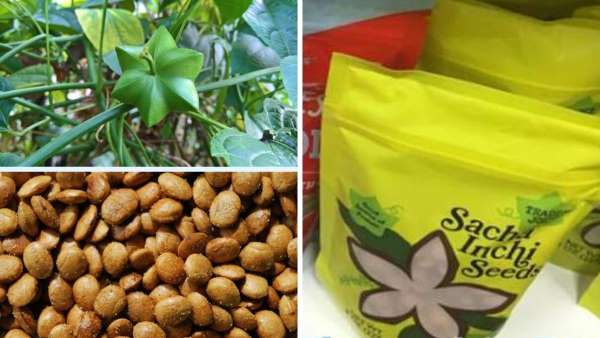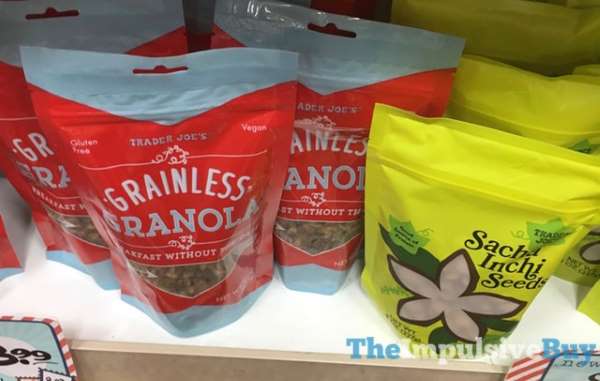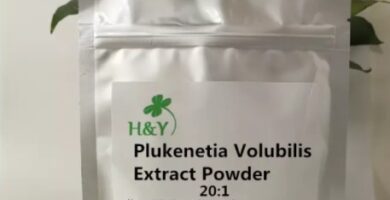
What is Sacha Inchi?
Sacha Inchi also known as sacha maní, sacha yuchi, sacha yuchiqui, maní del monte, maní inca (or inca peanut), among others, is a climbing and semi-woody plant belonging to the Euphorbiaceae family (Flores and Lock, 2013).
In addition to Plukenetia volubilis, other species are recognized: P. polyandenia Muell, P.loretensis Ule and P. brachybotrya Muell .
A new species Plukenetia huayllabambana was reported in 2009 (Dostert, Roque, Brokamp, Cano, La Torre and Weigend, 2009).
Plant Plukenetia volubilis L.
This ancient plant is native to the Peruvian, Ecuadorian and Colombian Amazon(Alimentos Andinos, 2020). Its rich history dates back to the Inca empire, cultivated for some 3,000-5,000 years,
“…because phytomorphic huacos representing the fruit of P. volubilishave been found in Inca tombs along the Peruvian coast…”
Flores, 2010
Its habitat is humid tropical forests, with temperatures from 10 to 36ºC and it adapts from 100 to 1,500 meters above sea level.
It grows wild and requires water and abundant light for its good development (Flores, 2010).

However, farmers also produce Sacha Inchi because it is a promising non-traditional crop in the Amazon, given the increasing global demand for healthy and organic food.
Its range extends from the Lesser Antilles, Suriname and the northwestern sector of the Amazon basin in Venezuela and Colombia to Ecuador, Peru, Bolivia and Brazil (Flores and Lock, 2013).
Benefits of Sacha Inchi
On the other hand, according to Alayón and Echevarría (2016), the consumption of these almonds and their food derivatives provides medium and long-term benefits in the prevention of cardiovascular diseases .
It has been possible to verify the improvement of fasting and postprandial lipid profiles in people who habitually use these products, being a natural alternative for the management of these diseases.

Author: Roger Culos, collection of the Musée de Toulouse CCby3.0
The presence of antioxidant compounds may contribute to protection against cellular oxidative damage.
The results of research conducted on animals and humans have demonstrated the harmlessness of Sacha Inchi, therefore, in general, it does not present any contraindication.
This Amazonian peanut also…
- Strengthens the immune system;
- Helps to lose weight;
- prevents diseases of the nervous system;
- improves concentration;
- reduces the symptoms of inflammatory diseases such as rheumatoid arthritis and gastrointestinal infections;
- and fights constipation.
On the other hand, its flour is suitable for coeliacs and has a high protein and amino acid content; it is used for both human and animal consumption (Flores and Lock, 2013).
Nutritional value / Superfood!
The first scientific mention of Plukenetia volubilis L. was made in 1980 by researchers at Cornell University, USA, who demonstrated that the seeds have a high protein (33%) and oil (49%) content, among other nutrients and vitamins. Of this last percentage, almost all corresponds to unsaturated fats, including omega 3, 6 and 9 (Abad, 2010).

Author: César Torres(CCby2.0)
Oil
Likewise, the oil also called sacha yuchiqui (once the seed is processed) is considered superior to other edible oils, as its good fats reach up to 93.6% of its composition (Abad, 2010).
Recipes
This peculiar star-shaped fruit is a very beneficial food for health, especially for children and the elderly.
The seeds can be boiled or roasted, and daily consumption is recommended.
The oil extracted from them is used raw in salads, or 1 or 2 teaspoons in main meals (Abad, 2010).
Almonds are also used in the preparation of traditional Peruvian foods, snacks and beverages:
- Inchi capi (chicken or beef soup with peanuts);
- Lechona api (plantain mazamorra with peanuts);
- Cutacho (ground green plantain with peanuts);
- Sacha Inchi butter; pururuca (ripe plantain with peanuts);
- Inchi cucho (chili with peanuts),
- Tamale of Sacha Inchi (corn with peanuts);
- Upe (roasted corn ground with peanuts);
- Chicha (white corn and peanuts);
- Salditos (toasted seeds with salt);
- And Sacha Inchi nougat (Flores, 2010).
- It is also added in desserts.
Uses and applications
This fruit can be consumed in almond, oil, flour, capsules and food supplements, as well as in beauty products for skin, nails and hair care, which offer excellent regeneration and hydration due to their high content of fatty acids and vitamins.
The people of the indigenous tribes of the Peruvian Amazon consume Sacha Inchi almonds as an energizer, to regain strength after labor-intensive work.
The women of these communities mix flour with oil from this Inca peanut, which they apply as a rejuvenating and revitalizing skin cream; they also rub the seed oil on their bodies to relieve rheumatic and muscular pains (Saldaña Rojas, 2009).
Likewise, some people of the Amazon consume the tender leaves of Sacha Inchi raw in salads and the cake (from the flour of the seed) is used for both human and animal food.
The oil obtained from this fruit is also used for food and fuel purposes.
Sacha inchi products – Where to buy?

References
- Abad, S. Sacha Inchi and its nutritional value. (April 12, 2010), retrieved from http://www.promueveperu.com.
- Alayón, N. and Echevarría, I. 2016. Sacha Inchi(plukenetia volubilis): a wasted ancestral experience? Clinical evidence associated with its consumption. Revista chilena de nutrición, vol. 43, (2), pp. 167-171.
- Andean Foods. 2020. Sacha Inchi, recovered from http://www.alimentoandinoespaña.es.
- Arias, L. F. Sacha Inchi: Making way for non-traditional crops. (September 23, 2019), retrieved from http://www.agronegocios.uniandes.edu.co.
- Dostert, N., Roque, J., Brokamp, G., Cano, A., La Torre, M. I., and Weigend, M. 2009. Factsheet: Botanical data of Sacha Inchi. Plukenetia volubilis L. Document D38/08-13, retrieved from http://www.botconsult.com. (PDF).
- Flores, Diana. 2010. Historical use: Sacha Inchi. Plukenetia volubilis L., retrieved from http://www.repositorio.promperu.gob.ve. (PDF).
- Flores, D. and Lock, Olga. 2013. Revaluing the millenary use of sacha inchi (Plukenetia Volubilis L.) for nutrition, health and cosmetics. Revista de Fitoterapia, (1), pp.25-30. (PDF).
- Saldaña Rojas, J.S. 2009. Products and markets. Non-Wood News, (18), January, pp.22-36, retrieved from http://www.fao.org. (PDF).

Economist (Central University of Venezuela). Full professor and researcher attached to the “Edgar Abreu Olivo” Agrifood Research Center, Universidad de Los Andes. Doctor from the University of La Laguna (Spain). Award “One of the 10 most consulted authors of the Saber ULA university portal” (2005); prize in the III Essay Contest of the Central Bank of Venezuela BCvoz Economico, 2016, with the work “Theobroma cacao: transformation and consumption of the “food of the gods” in Venezuela and the world” (co-authored).
This post is also available in:
![]() Español (Spanish)
Español (Spanish)



